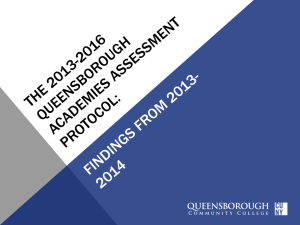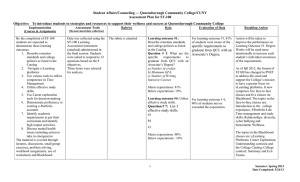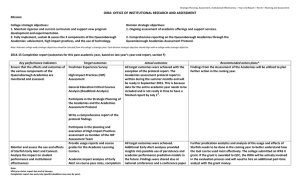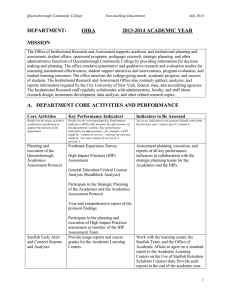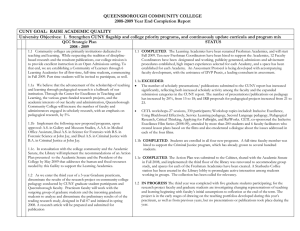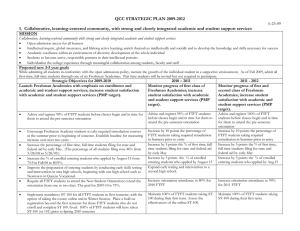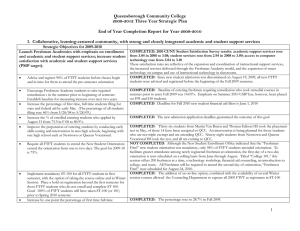The 2013-2016 Queensborough Academies Assessment Protocol: Findings from 2013-2014
advertisement
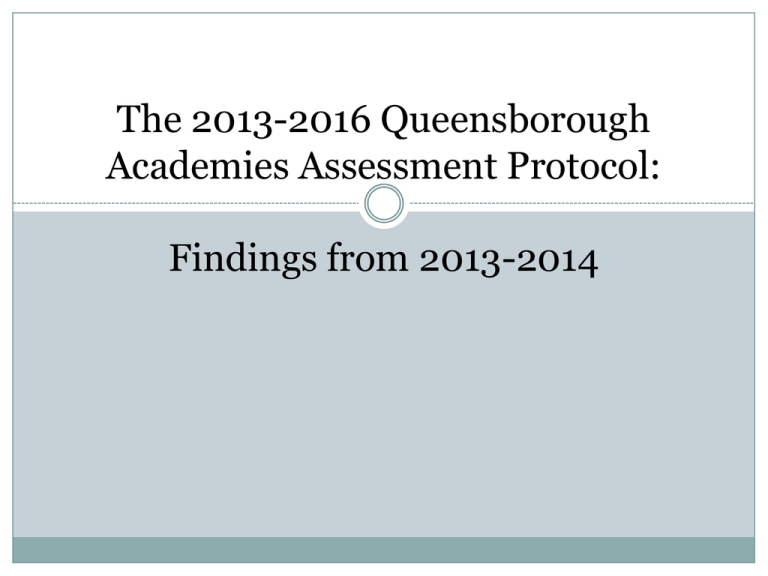
The 2013-2016 Queensborough Academies Assessment Protocol: Findings from 2013-2014 The Queensborough Academies Assessment Protocol … … guides the impact assessment of the Queensborough Academies … is a modified and expanded version of the original assessment protocol of the Freshman Academies. … was developed with input from Academic Affairs; Strategic Planning, Assessment, and Institutional Effectiveness; Student Affairs; and faculty. The Office of Institutional Research and Assessment is executing and coordinating the assessment based on the protocol (Dr. Fichera, Dir. Lackner) The Areas, Assessment Methods, and the three “Prongs” of the Queensborough Academies Long term objectives: Increased graduation; retention; student satisfaction Areas Assessment methods Prongs First Semester Student Experience First Semester Freshman Experience Survey Advisement and student support Student Support Network through use of Technology (Starfish) and Student Services Analyses of Starfish Early Alert usage and the Technology effects on course performance High Impact Practices HIP Experience Survey Critical Course Analyses Review of key courses with high failure and withdrawal rates High Impact Practices http://www.qcc.cuny.edu/oira/docs/Academy-Assessment-Protocol.pdf Additional assessment activities Examples CUNY Student Experience Survey (every other spring) Noel Levitz Student Satisfaction Inventory (every other spring) Analyses of association between HIP experiences and course performance and college persistence OIRA internal analysis of graduation, retention, and transfer out rates Highlights of Findings 2013-2014 First-Semester Student Experience Survey Early Alert High Impact Practice Experience Survey Critical Course Analysis Long Term Objectives First Semester Student Experience Survey N = 683 81 % of freshmen who attended orientation events agreed that these events made them aware of the Academy they belong to 73 % of freshmen who interacted with their Academy Adviser since the start of the semester agreed that this interaction improved the connection to the college community 92.4 % of freshmen have had no difficulty navigating through college procedures in their first semester 98 % of freshmen had a positive (70.8%) or very positive (27.1%) attitude towards QCC. Student Support Network: Starfish Early Alert Remedial course sections that used Early Alert had higher course pass rates and completion rates (group average) than sections that did not participate in Early Alert. Math gateway courses (group average), BU 101: Principles of Accounting I, BU 201: Business Organization and Management, and Psychology 101 saw higher course pass rates since the start of Early Alert. Unofficial withdrawal rates (WU grades) have declined since fall 2013 in credit bearing courses campus-wide. Flagged students tended to be weaker students. Flagging alone does not get students to tutoring; referrals are a potent action. Students referred to a learning center through Starfish were much more likely to receive tutoring than students who were only flagged. Tutoring resulted in higher course pass rate gains for flagged students than for non- flagged students. High Impact Practices Experience Survey N = 630 Students who had experienced one or more HIPs in fall 2013 offered the following feedback in the survey: 70% felt more comfortable interacting with people from different backgrounds and cultures 68% felt that their writing improved. 70% had used reflection to improve learning. 69% have been motivated to invest more time and effort into learning. Critical Course and Program Analysis General education gateway courses with below 50% pass rate (C or better) of enrolled students in all fall and spring terms since fall 2010. These heavily enrolled courses, critical for student progress through the curriculum, have high official withdrawal rates every term: BI 201: General Biology I BI 301: Anatomy and Physiology I HI 110: Introduction to Ancient Civilization HI 112: Introduction to Modern Western Civilization MA 120/119: College Algebra VP Karen Steele (Strategic Planning, Assessment, and Institutional Effectiveness) is leading in-depth reviews and discussions with the departments to determine potential causes and possible remedies. Additional data provided by the OIRA office was reviewed, such as remedial needs, course performance in related areas (Mathematics and Chemistry for BI 201 and 301, English for HI 110 and 112), and academic performance and enrollment history of students. Long term objectives: Increase Retention & Graduation QCC retained/ graduated Additional QCC students retained/graduated at other CUNY colleges Rates published in academic year 2013-14 2012-13 2013-14 2012-13 Additional QCC students retained/ graduated outside CUNY Overall Rates National Average ¹ 2013-14 2012-13 2013-14 2012-13 2013-14 One year retention rate: 70.9% 69.2% 2.0% 1.2% 3.4% 3.4% 76.3% 73.8% 57.1% Three year graduation rate: 18.5% 16.2% 0.5% 0.5% 0% 19% Four year graduation rate: 23.5% 20.7% 0.8% 1.3% 0.5% 1.4% 24.8% 23.4% 20.7% Six year graduation rate QCC: 28.7% 25.3% 5.8% 5.4% 3.0% 3.3% 37.5% 34.0% 0% ¹National Average of all Public Urban Associate’s Institutions. Data Source: IPEDS Data Center: nces.ed.gov/ipeds/datacenter 16.7% 15.4% -- The entire report can be found at: http://www.qcc.cuny.edu/oira/index.html Any questions? Elisabeth Lackner elackner@qcc.cuny.edu or at extension 6279
